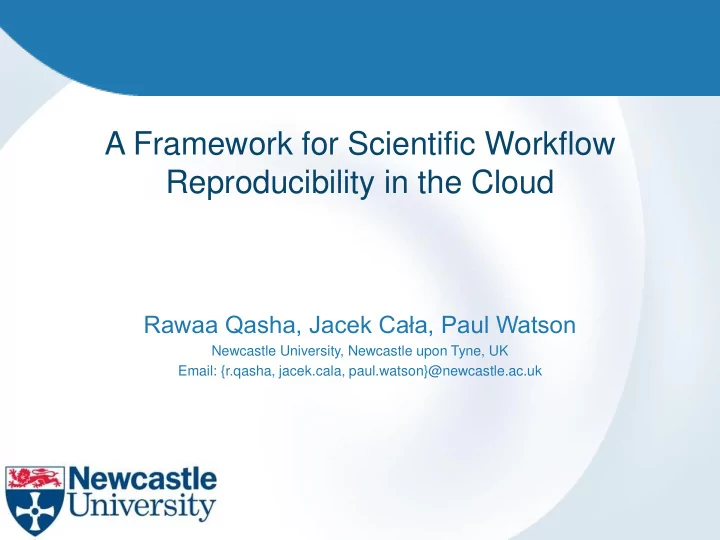

A Framework for Scientific Workflow Reproducibility in the Cloud Rawaa Qasha, Jacek Cała, Paul Watson Newcastle University, Newcastle upon Tyne, UK Email: {r.qasha, jacek.cala, paul.watson}@newcastle.ac.uk
In this paper • A new framework for repeatability and reproducibility of scientific workflow • Integrating logical and physical preservation approaches • Offering Workflow/tasks repositories with version control • Supporting automatic deployment and image capture of workflows and tasks 2
Outline • Background • Challenges for workflow reproducibility • Our solution for logical and physical preservations • Overview of reproducibility framework • Experiments and results • Conclusions 3
Workflows & Reproducibility total no. of workflows Workflows can be re-excuted 1600 Number of workflows 1400 1200 1000 800 1443 600 400 341 200 (~24%) 18 (~20%) 92 0 study1* study2** 4 * Zhao et al, “ Why workflows break Understanding and combating decay in Taverna workflows ,” 2012 ** Mayer et al, “A Quantitative Study on the Re -executability of Publicly Shared Scientific Workflows”, 2015
Challenges for workflow reproducibility • Insufficiently detailed workflow description • Insufficient description of the execution environment • Unavailable execution environments • Absence of & changes in the external dependencies • Missing input data 5
Common reproducibility approaches Logical preservation T2 T1 T4 T3 Physical preservation 6
Using TOSCA as a logical preservation Service Template Node Node Type Template (T1) T2 T1 Node Node T4 Template Template (T3) (T2) T3 Relationship Type Node Template (T4) 7 Workflow and execution environment description
Using Docker for physical preservation Tools & Task Libs. artifact Data base Container Container Image Task image image creation With Depend. creation (a) Initial task deployment & execution Data Task Container image creation (b) Task deployment & execution with task image 8 Preserving execution environment and dependencies, tracking changes
Reproducibility Framework Core Repository (GitHub) Task/WF Images Repository Repository LifeCycle (GitHub) Basic Types ( Docker Hub ) Scripts Automated Workflow Deployment & Enactment Engine Image (TOSCA Runtime Environment: Cloudify) Creation Target Execution Environment (Docker over local VM, AWS, Azure, GCE, …) 9
Multi-container deployment 10
Single container deployment 11
Time line of workflow devOps 12
Workflow repository 13 Preserving description, input data, tracking changes and deployment instructions
Experiments and Results 14
1- Repeatability of a workflow on different clouds 15
2- Automatic image capture for improved performance 16
3- Reproducibility in the face of development changes 17
Conclusions • Full workflow reproducibility is a long-standing issue • TOSCA description is used for logical preservation • Docker images for tasks/workflows support physical preservation • Changes tracking and automatic deployment also contribute to a comprehensive solution of the problem • Integration of these techniques addresses majority of the issues related to workflow decay 18
THANK YOU
Recommend
More recommend